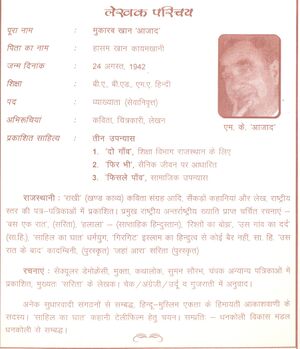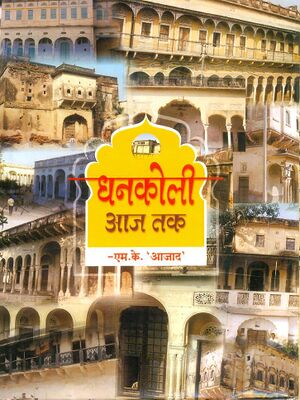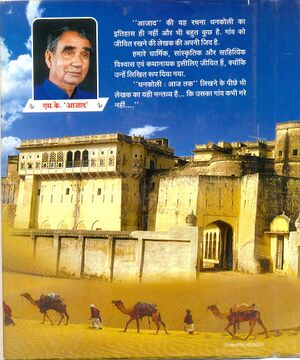M.K. Azad
M.K Azad (मुकारव खान आज़ाद) (b.24 August 1942) is a retired Lecturer from Dhankoli and author of many novels and books.
He has authored a Book in Hindi on Dhankoli titled - Dhankoli Aaj Tak (धनकोली आज तक). It is Published by Dhankoli Vikas Mandal, Dhankoli, 2004. The book contains very useful informations about the notable persons of the village, history of village and communities living there with their migrations. Author has provided the genealogy of all the castes living in the village. We have taken here the history concerned with Jat clans from this book.
Contents
Introduction
Dhankoli is an ancient village. The village was founded near a big pond. According to M.K. Azad the village was founded earlier than 1500 AD as the Kayamkhani records reveal that Nawab Asal Khan had handed over the Jagir of Dhankoli to his brother in period 1500-25. (M.K. Azad p.34)
In ancient times this village served as a camping place for caravans carrying goods from Bikaner and Shekhawati. Kuchaman was the next camp after Dhankoli. The goods included daily use items like food grains, sugar, gur, oils, misri, hirmach, paliabhata, namak, clothes etc.
Here is the brief history of Jat clans living in village Dhankoli:
History of Bijarnia
Dhankoli has population of Bijarnia Jat Gotra. The Bahi of the bard (Raoji Bajrang Singh, Dalania, Phagi, Jaipur) of Bijarnia reveals that One Bijarnia ancestor had come to Dhankoli in samvat 1609 (1552 AD) during the period of Kayamkhani rulers at Dhankoli and the rule of Humayun at Delhi.
Jag Singh Chaudhary was an officer in the Army of Mughal emperor Humanyun. Badshah was very pleased with his services so he offered him a Jagir of 12 villages in samvat 1503 (1446 AD). Jagsi Bijarnia had 12 sons and one Paswan son named Rupsi.
Local tradition tells us that Jakhar Kunwar of Mandoli (Bairath) was married in the family of Bana Jat of Jayal Bhadana. Jakhar Kunwar was returning after his gona with his wife Bijli. He stayed at Ladhana. Meanwhile Jagsi’s Paswan son Rupsi was going to forest for hunting and he also stayed at Ladhana for a while. The newly married wife Bijli of Jakhar Kunwar was very impressed with the behavior of Rupsi. She praised the qualities of Rupsi in front of his husband. (M.K Azad, p.196)
This annoyed Jakhar Kunwar and he scolded her for this behavior, left her behind and went away without her. Bijli was a simple and humorous girl. She had not anticipated this before. When Rupsi came back from hunting he found Bijli weeping with sorrow. Rupsi said since he is responsible for this incidence he offered that she could go with him if she had no objection. She was left with no option so decided to go with Rupsi.
Jakhars when learnt that their bahu had gone with Bijarnias they got annoyed over this incidence and complained to Delhi Badshah. Jakhars attacked Bijarnias with an army of 2200 soldiers on chaitra sudi 8 samvat 1510 (1453 AD). Bijarnias had blessings of Jeenmata that they could not be defeated. The 12 brothers who were initially keeping a distance with Paswan brother Rupsi also joined him in war against Jakhars.
Though all brothers fought war but it was made clear during the war by elder Bijarnia that Rupsi had created this problem so he would be dealt accordingly after the war. Rupsi when learnt about this dictate of elder Bijarnia he left Ladhana with Bijli and went to Shrimadhopur. His descendants flourished there.
Jagsi Bijarni family moved from Ladhana to Palsana in Sikar district. Jagsi had two sons Bindra and Alha. Alha was an ambitious and far sighted person. He came to know that Badshah Humayun was returning from Ajmer after performing jiyarat at Ajmer Dargah and going to capital Delhi. He offered for a feast to the Badshah to please him. Badshah accepted it and Alha gave a grand feast of khir-churma to Humayun. (M.K Azad p.197) Humanyu liked the Rajasthani food. He was pleased with Alha and gifted him 5500 bigha land. Alha was a kind man. He left a gauchar land and constructed a talab there. This Johad is still present and called Alhana Talab. Bijarnia descendants constructed many talabs in Dhankoli also.
Jagsi’s sixth son was Nihalji. Nihalji begot son Panagji who begot son Balu Ramji. Balu Ramji’s grand son Tola Ram ji constructed Tolana Talab and left auran (catchment) land 200 bigha in samvat 1620 (1562 AD). In the fourth generation Hemaji constructed Hemnana Talab in samvat 1695 (1638 AD) in west of Dhankoli.
Chaudhary Narbadji constructed Narbadana Talab in 300 bigha in samvat 1751 (1694 AD) in east of village. Narbadji’s son was Koju Ramji and his son was Harji Ramji who constructed ‘Har Jo Lav’ Talab in 50 bigha in Jhajhara’s fields in samvat 1825. Harji Ramji’s son was Kana Ramji who built a well in samvat 1875 in east of village. Kana Ramji built a 6 pillar chhatri after his father near the village well in samvat 1879. (M.K Azad p.198)
Notable persons:
- Balu Ram Bijarnia – He was a freedom fighter and farmer from Dhankoli, who struggled against Jagirdars.
History of Tetarwal Gotra
Tetarwal Jats came to Dhankoli in samvat 1675 (1618 AD) after paying respect to their family deity goddess ‘Saunth Mata’. Saunth Mata is their kuladevi. They do not offer Saunth to ladies during delivery period.
Local tradition reveals that one Tetarwal woman came to the village well, which was constructed by Bijarnias, for taking drinking water. She was in hurry and requested to let her take water first. Other ladies commented that this not Tetarwal’s well and if she was in such hurry Tetarwals should dig their own well. Tetarwal lady came back without water and told to her family. Tetarwals decided not to take water from Bijarnia’s well. They decided to dig their own well till that time they brought water from nearby village Asalsar.
Khemji Tetarwal’s son Poosa constructed and completed a well on Jeth Badi 3 samvat 1692 (1635 AD). This well was known as ‘Mithi Kothi’.
Tetarwals also constructed, near this well, a temple of Balaji and temple of Tamadayatas (Maharshi). (M.K Azad p.203)
Notable persons:
- K. R. Chaudhary (Tetarwal) - He is member of Purwanchal Pradesh Marwari Sammelan established 1935.
- B R Chaudhary – Bhura Ram Tetarwal - Industrialist : Light Metals Aluminium
History of Bagaria Gotra
Bagarias were originally settled at Sikar where there is fort of Sikar. The Shekhawat Jagirdar displaced them from that place to construct Fort. The Bagarias got annoyed with Jagirdar on this displacement and they left Shekhawati area and settled in Fatehpur which was under Kayamkhani Nawabs. Later they left that area also and came to Dhankoli. The ancestral person of Bagarias was Khuma Ram who had four sons Gordhan, Nadu , Pema and Hari. Gordhan had four sons: Uda, Ramu, Gidha and Sewa. Ramu’s son Jagu came to Dhankoli in samvat 1825 (1758 AD).
Bagarias in Dhankoli live in Aguna Bas. They became Marjidan of Thakur and got permission to construct Haveli. Their grand Haveli was constructed in magh sudi 10 samvat 1980 (1932 AD).
Notable persons:
- Pusa Ram Bagaria – Born on 5.1.1934 in family of Pema Ram Bagaria. Did B.A. LLB and joined CBI. He was promoted to Assistant Director Prosecution in 1988.
- Ramu Ram Bagaria – He was sarpanch for longest period.
- Dalu Ram Bagaria – Sarpanch in 1987. He is bhatija of Ramu Ram Bagaria
Reference - (M.K Azad p.207-8)
History of Jhajara Gotra
Jhajara is same as Jhajaria. Due to differences with thakur they left Dhankoli and went to village Baldu (tahsil:Ladnu). Gangoji Tetarwal brought them back to Dhankoli in samvat 1968. ( M K Azad, p. 211)
History of Bhinchar Gotra
Their original habitation of Bhinchar Gotra people was in Gujarat. Some ruler from Sambhar settled Bhinchawa village. They had war with Borawar Rajput ruler. This ruler took away Kalwa from Dukiya Jats. Bhichars opposed this.
One family of Bhinchars lived with Kukana Jats of Kukanwali. Then they settled in Nalot. Later they founded ‘Bhincharon Ka Bas’.
Kesar Singh Bhinchar of this gotra was a great warrior. One Rajput lady was his dharmbahin. Shekhawats took away cows of this lady. On the request of Rajput lady Kesar Singh followed the thieves. He encountered them at Mundwara fought with them bravely with sword and got back cows from them. Kesar Singh was returning back with cows when the enemies attacked him from behind when he was unprepared. His head was chopped off. Even after chopping of head he moved headless on horse up to ‘Lamba Kotda’. This news spread in the area like jungle fire. When the Rajput lady learnt it she rushed to the spot and tied a rakhi thread to him. Then only his head felled on ground. Rajputs and Bhinchars constructed a chhatri on the Samadhi of Kesar Singh Bhinchar here. This chhatri is very sacred today.
Bhinchars came to Dhankoli in samvat 1982 from Moriyawat (मोडियावट) to ‘Bhincharon Ki Dhani’ and finally to Dhankoli.
Bhinchar are also called Bhainchar, Bhachar , Bhaskar etc due to linguistic variations.
Reference - (M.K Azad p.212-13)
History of Jethoo Gotra
Jethoo - Jethoo of the village came from Bhadana and then to ‘Jethwan Ka Bas’ in Sikar district. Some families had gone from here to ‘Jan Jhadeli’. Uda Ram Jethoo was first to come to this village in samvat 1950. Uda Ram Jethoo is an expert chejara, whose name is engraved on Laxman Jhula in Haridwar.
Notable persons: Shrawan Ram Choudhary (Jethoo) - Asstt. Commandant CRPF,VPO- Dhankoli, Distt. - Nagaur, Present Address : M-184,Sect.6, Kendriya Vihar, Vidyadhar Nagar, Jaipur, Resident Phone Number : 0141-2232856 . (M.K Azad p.215)
Other Jat clans
- Chahar (3) - There are three families of Chahars in Dhankoli. They came from Bhadaliya. (M.K Azad p.213)
- Kaswan - Kaswan came to Dhankoli from Kursia (Khushiya) Gawaria village to Nawa to Dabra and then to Dhankoli. (M.K. Azad, p.213)
- Nain (4)
- Bugalya (1)
- Thalod (2) – Came from Asalsar
- Mandha (1) – Came from Lunoda in 1970
- Khokhar (2) – Came from Hirani (Bhanwata)
- Lamrod (1) - Came from Hirani (Bhanwata)
- Bhakhar (7) – Came from Khakholi
Contact details
External links
Read more at
References
M.K. Azad : Dhankoli Aaj Tak (धनकोली आज तक). Publisher: Dhankoli Vikas Mandal, Dhankoli, 2004.
Back to Jat Historians


